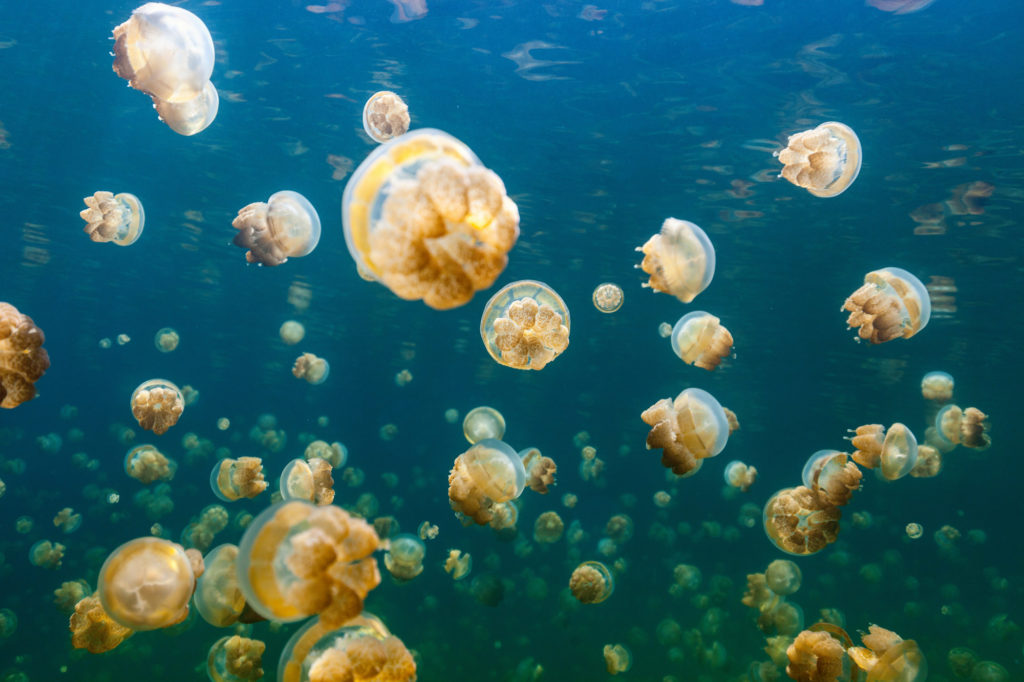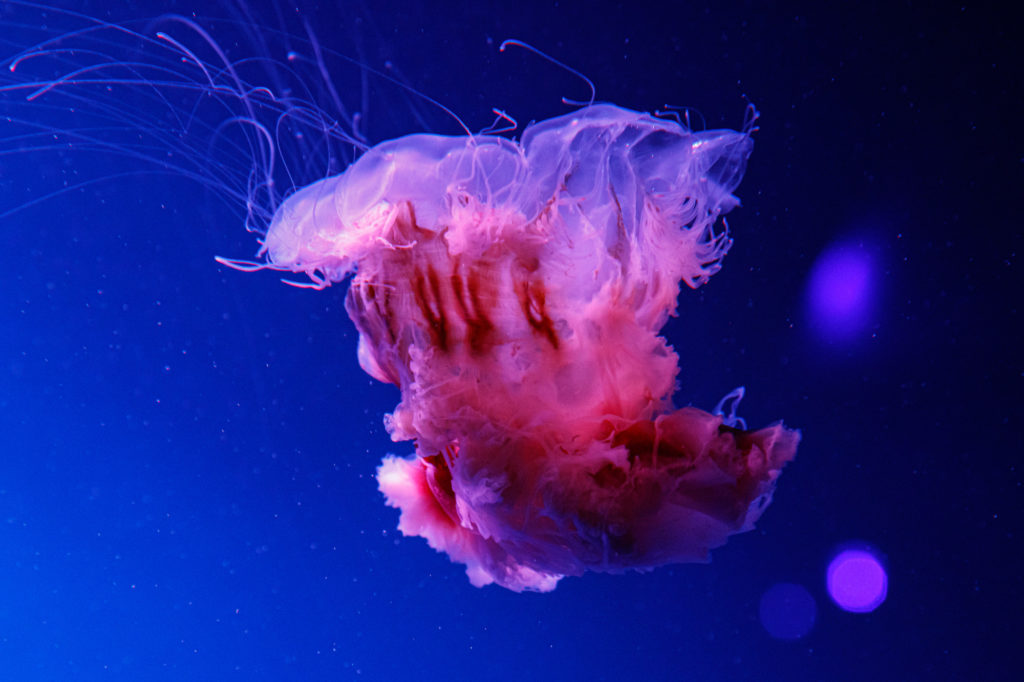Jellyfish are truly amazing creatures!
There are lots of people who are intrigued by them and want to learn more. We researched the most asked questions about jellyfish and have answered them below:

65 FAQ About Jellyfish
- What is a jellyfish? Jellyfish are very simple creatures. They lack brains, blood, and even a heart. What they do have are elementary nervous and digestive systems that enable them to respond to stimuli and consume food.
- Can a jellyfish sting kill you? There are some species of box jellyfish that can create a potent enough venom to kill a person. However, this is very rare, especially in Hawaii and near other US coastal waters.
- Are jellyfish harmful to humans? Jellyfish are harmful to humans in that their stings are painful. Most people report pain from a jellyfish sting lasting up to a couple of hours. However, bad stings can cause raised, red welts that may linger for up to a month after the sting. In some cases, a jellyfish sting may result in nausea, diarrhea, vomiting, back pain, lymph node swelling, fever and fever-like symptoms. In very, very rare cases, a person may fall into a coma or risk death.
- How do Jellyfish eat? The stinging cells within the tentacles that can cause pain to humans are designed to stun and paralyze shrimp and small fish. Jellyfish stun these creatures and then use their tentacles to push the items into their “mouth”.
- How do Jellyfish sting? Those tentacles that stun prey are the same things that sting humans. The “stinging” is really the injection of tons of tiny hits of venom from the bulbs that run along each of the creature’s tentacles. It’s important to note that jellyfish don’t mean to sting humans, but they can easily sting a human when they brush up against their tentacles.
- What are jellyfish made of? The primary substance layer of jellyfish is made of “mesoglea” which is a unique tissue only found in cnidarians like jellyfish and coral. There’s also an outer layer called the “epidermis” which contains the nerve net, and then an inner layer called the “gastrodermis” which contains cells that digest nutrients.
- Which jellyfish is the most dangerous? Certain species of box jellyfish are the most dangerous like the Australian box jellyfish which can be fatal. Following it is the Irukandji jellyfish which can cause brain hemorrhages and fatality.
- Which jellyfish can you eat? Chinese and other Southeast Asian populations have been catching and eating jellyfish in the Rhizostomae order for over 1,700 years. While there are some other species of jellyfish that are safe and popular to eat, these species remain the most popular in culinary pursuits.
- How do jellyfish reproduce? While a couple of jellyfish species reproduce in a more traditional way by taking in sperm to fertilize eggs within the body cavity, most jellyfish species do not reproduce this way. Most jellyfish release sperm or eggs into the water where they fertilize each other. These eggs hatch into flatworms. Some flatworms grow directly into jellyfish while others form a polyp off of which tiny jellyfish form in an asexual reproduction cycle.
- Do jellyfish have a brain? No, jellyfish don’t have a brain. They do, however, have neurons throughout that can send signals throughout their body.
- How do jellyfish breathe? Jellyfish don’t breathe in oxygen through gills or a mouth, but they do absorb oxygen through their gelatinous outer body.
- How do jellyfish eat? Jellyfish stun their prey with venom and then use their tentacles to guide the food into their mouth. Some species also eat plant life that doesn’t need to be shocked like this.
- Do jellyfish glow? Yes! Some species of jellyfish are able to glow through a process called phosphoresces in which they absorb energy from other sources (like food) and release it in the form of light.
- Where do jellyfish live? Jellyfish are like the cockroaches of the sea in that they can live and thrive anywhere. This includes warm tropical waters around Hawaii as well as the frigid waters of the Arctic. As far as locations, jellyfish are known to be extremely common at Palau Rock Islands and in French Polynesia.
- Are jellyfish immortal? Short answer, no. However, there is a species of jellyfish that can live for such a long, long, long period of time that scientists consider them “immortal”.
- Why do jellyfish come to shore? Jellyfish aren’t strong swimmers and so go generally wherever the currents, tides, and winds take them. Often, this means to shore.
- Are jellyfish actually fish? No, they are as different from fish as humans are from birds.
- Why are jellyfish dangerous? Those stingers are painful and because they can cause ugly symptoms (and rare fatalities), jellyfish are slightly dangerous.
- Why do jellyfish sting? Jellyfish sting for the same reason many sharks bite, they bump into something they think might be food and try and eat it.
- Are jellyfish conscious? Jellyfish have no brains and therefore are not aware of their own existence. So no, while alive they are not “conscious”.
- Are jellyfish edible? Some species are and have been served as food for over 1,700 years.
- What type of animal is a jellyfish? Jellyfish are invertebrates and members of the Scyphozoa class.
- Can jellyfish sting through a wetsuit? No.
- Can jellyfish live out of water? No, jellyfish can only absorb oxygen through seawater and so will die once beached.
- Can jellyfish see? Jellyfish don’t have eyes to see as we would perceive it, so not really. Some jellyfish can sense changes in light, however, and some eye spots are even well-developed enough to be able to see (although rare).
- Can jellyfish feel pain? Jellyfish are one big neural network and respond to stimuli. So while they don’t feel the same type of pain other animals do, they do know to remove themselves from bad stimuli.
- Will a jellyfish sting leave a scar? In rare cases, yes.
- How many types of jellyfish are there? There are over 2,000 different types of jellyfish.
- What does a jellyfish sting look like? While some jellyfish stings leave welts that look as though a person was whipped, others look like a rash with patches.
- How do you treat a jellyfish sting? First, pluck out any visible tentacles with tweezers. Then rinse with vinegar and soak in hot water. Seek medical treatment if the pain continues.
- Does peeing on a jellyfish sting help? No. A popular myth — this trick might take your mind off the pain, but it doesn’t actually relieve the pain.
- What is the difference between a jellyfish and a Man o War? The Man O’ War is actually four co-dependent animals whereas a jellyfish is a single creature.
- What is the deadliest jellyfish in the world? The box jellyfish.
- What good do jellyfish do? Jellyfish help certain species of venom-resistant fish survive as those fish use jellyfish tentacles as a place to hide from other predators.
- Do all jellyfish sting? No, some like the Pleurobrachia Bachei or Aurelia Aurita don’t sting at all.
- What kills jellyfish? A lot of animals prey on jellyfish, including sea anemones, tunas, sea turtles, and crabs.
- How long do jellyfish live? Some species live only a few months while others are practically immortal.
- Do jellyfish eat other jellyfish? Yes! Some jellyfish will eat just about anything that comes in contact of their stinging tentacles — and that includes other jellyfish.
- What is a bloom? A bloom is whenever there is a huge growth of jellyfish in a specified area. Think of it as a cloud of jellyfish. Jellyfish blooms happen more frequently in the spring and summer seasons.
- How do jellyfish blooms form? They happen naturally due to ocean and wind patterns that bring a ton of similar jellyfish together.
- Do jellyfish have bones? No, jellyfish have no bones and are gelatinous in substance.
- Do jellyfish swim horizontally? They can! Most jellyfish will travel by and large on the currents, but they can still swim with purpose horizontally, vertically, or diagonally.
- Can jellyfish clone themselves? Some species of jellyfish partially reproduce asexually, which is to say they don’t need any other jellyfish to contribute sperm or eggs. When they do this, they essentially make clones of themselves.
- Do jellyfish lay eggs? Most jellyfish do reproduce by releasing eggs directly into the water.
- How do jellyfish swim? Jellyfish swim by squeezing tight and then relaxing a specializing ring of muscles at the bottom ring of their bell. This motion draws in water and then pushes it out, propelling the jellyfish forward.
- How are jellyfish’s digestive systems different than ours? Theirs is a very simplified system in which food enters, gets trapped into the cavity, base nutrients are absorbed, and then the waste products are pushed back out through the mouth.
- Do jellyfish die after they sting you? No, the jellyfish’s capability to sting is a core part of how they eat and survive.
- Do jellyfish eat humans? Theoretically, a jellyfish the size of a whale in width could “eat” or gain nutrients from a dead human. But such-sized jellyfish don’t exist and so no, no existing species eats humans.
- What is special about a box jellyfish? Box jellyfish have the most lethal stinging capabilities and are more evolutionary advanced than other species.
- How big is the smallest jellyfish? The Irukandji jellyfish is the smallest jellyfish at only 1 to 2 cm in diameter.
- How big is the largest jellyfish? The lion’s mane jellyfish is the tallest or largest jellyfish with its capability of stretching 120 feet from top to bottom. The largest jellyfish can also weigh up to 450 pounds!
- What does a jellyfish feel like if you touch it? The top of a jellyfish feels like a very taunt jello covered by a thin plastic layer.
- Can jellyfish sting when they are dead? Yes! Take care when being near dead jellyfish as they can sting as long as their tentacles hold the necessary venom.
- Which is older – Jellyfish or Dinosaurs? Jellyfish are 250 million years older than the first dinosaurs.
- Have jellyfish been to space? Yes, in 1991, NASA sent jellyfish to space to study the gravitational effects on jellyfish.
- Do jellyfish have organs? No, they lack any organ system.
- What do you call a large gathering of jellyfish? A big group of jellyfish is called a “smack” but a sudden large swarm or growth of jellyfish is called a “bloom”.
- Do jellyfish only live in the ocean? No, some species of jellyfish can and do live in freshwater systems.
- What are popular remedies for jellyfish stings? Vinegar and baking soda are the most popular home remedies for relieving stings.
- Which animals are predators to jellyfish? Many marine animals eat jellyfish, ranging from crabs on the seafloor to tuna and big fish mid-ocean and even sea birds from above.
- Is it true that crabs sometimes ride on jellyfish? There have been sightings of crabs hitching rides to jellyfish.
- How many people are stung by a jellyfish annually? Around 150 million people! But the vast majority are minor, simply annoying stings that go away in a few hours.
- Do jellyfish or sharks kill more people each year? Jellyfish do kill more people on average than sharks.
- How fast do jellyfish swim? Jellyfish can swim at speeds upwards of 4 mph, which is twice as fast as the average swimmer.
- How do you keep jellyfish away from you? If you are worried about jellyfish, consider wearing jellyfish repellant or a stinger suit, which is like a lightweight wetsuit designed specifically to prevent jellyfish stings on the wearer.

Interested in More Jelly-Related Content?
Check out our Ultimate Guide to Jellyfish which covers different types of jellyfish, including the deadliest! You’ll also be able to see real-live photos of harsh stings, along with the behind-the-scenes stories of how individuals got stung.




